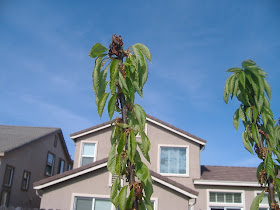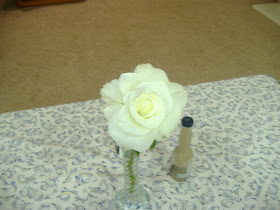The run of good gardening luck just continues to roll our way here at the North Natomas "Home for Wayward Heirloom Tomato Plants."
If that sounds rather facetious -- well Howdy Doo! It is. Our luck has been as absent as a warm spring day in April -- which happened on this date exactly two years ago.
Case in point? This little mess to your immediate right. Can you guess what that is kids? That is heartbreak on a stick. Make that a broken stick. That's actually a tree rose kids -- or what's left of a tree rose after a couple of days of fierce winds howling through the northern area.
We always get the wind just a little bit worse than most neighborhoods. Why? Well -- for one thing -- we're in the riverbottom. It just gusts. Secondly -- North Natomas is devoid of a natural windbreak in the form of mature trees. There weren't any in the riverbottom to begin with (well -- maybe a century or two ago) -- and the landscaping trees that have been planted in this new subdivision are far too small to make any sort of a difference when it comes to slowing down Mother Nature's springtime sneezing fits.
So -- it gusts -- and we deal.
This is not what I expected -- however. In fact -- this was the last thing on my mind. Danger to a tree rose? A well staked tree rose? A well staked tree rose with not one but two stakes? A well staked tree rose next to the house for added wind protection?
Color me surprised. In fact -- color me many different shades of surprised as that busted rose before you is known as a "Weeks 36 inch Twofers." What's a "Twofer" you ask? Well kids -- you're in luck! Because -- according to the Weeks Roses website, the "Twofer" is:
"(Roses that) are guaranteed to cause quite a clamor in your garden. Imagine the excitement of 2 colors of flowers on just one tree. We’ve carefully selected 2 different varieties that are perfectly balanced in flower size, floriferousness, foliage and habit to bud onto our 36″ Dr. Huey rootstock. A real attention-grabber!"
Dear Weeks: Consider my attention "grabbed." Mortified is more like it -- but on with the show here!
The "Twofer" rose now lying in "twopieces" in our Back 40 is the combined varieties of "Livin Easy" and "Easy Going." Venus actually spotted this in a Weeks catalog last year and remarked how much she'd like to have one. How I came into posession of this tree rose is a little bit of a surprise -- because it was not the "tree rose" that Bill Bird was looking for when he went about a shoppin nearly one year ago.
Regular readers of this blog know all too well who I turn too (run crying in desperation) when I have questions: Farmer Fred Hoffman. So -- I emailed him these photos with the question of: "Can it be saved." The thing I like about Fred is his straightforward honesty. He doesn't sugarcoat it. He advised me that the rose is probably a "goner" but also turned to Sacramento's premiere Rosarian -- Baldo Villegas -- for the practiced eye of rose assistance.
Know what Baldo said? It's a "goner." Fred went on to advise that he has also had his share of bad luck with tree roses -- a point backed up by Baldo as well. Their combined advice? Don't buy tree roses unless you really do like the feeling of being whipped with a rubber hose.
Eh -- scuse me -- but I really didn't have a choice in the matter.
Let me explain.
Venus has been asking (pestering) me for years to get the tree rose "St. Patrick" in honor of her mother -- who lost a valiant battle with cancer at far too young an age nearly five years ago. The St. Patrick tree rose was the preferred rose of the late Patricia (Pat) Stromberg. She made sure the St. Patrick was planted in every backyard she helped landscape and it was always the center of attention.
Therefore -- I knew my task last June when it came to fulfilling Venus' birthday request. She wanted a rose on her mother's behalf. Not just any rose mind you. Oh no -- it had to be the St. Patrick. Not only that -- it had to be the St. Patrick tree rose. Nothing else would suffice. It's that -- or try sleeping in the car for the next month Bill Bird.
Now -- I ask the fine ladies who frequent this blog just what happens to the unlucky husband if birthday wishes like this one are not fulfilled? Does a month in the GarageMahal doghouse sound like the appropriate punishment? Hmm??? Oh sure! The GarageMahal is decked out with a flat screen TV and a KEGERATOR. But let's be honest here. That's still a garage floor. It's concrete. It's cold. Try sleeping on a slab, son.
So -- off I went last year in search of Venus' demand. Bare root season was over. That was working against me. The St. Patrick also happens to be one of the more popular varieties. Strike Two. But I found what I was looking for at Capitol Nursery. They had one left. I bought it on the spot over the phone without even looking at it. And I also advised the very happy salesman that I would need a second tree rose to complete the layout -- so just "find something."
Imagine my surprise when I arrived at Capitol Nursery later that day to not only find the St. Patrick, but the Weeks "Twofer" rose that Venus had spotted in a catalog about three months earlier. It was an incredible stroke of luck. Venus gets her St. Patrick. She also gets the "Twofer."
Needless to say -- I wasn't forced to sleep in the GarageMahal for the next month.
I'll be honest. The roses were not in the best shape when I found them. Black spot and other leaf diseases had taken an obvious toll. The Weeks "Twofer" was bent at a crazy angle. It looked nothing like that nice looking rose in the Weeks catalog. I couldn't do much last year other than halt the spread of the leaf diseases with some applications of fungicide -- plus make sure the "Twofer" was planted at an even crazier angle so that it stood "straight up."
After cutting both tree roses back last fall -- I started the "baby effort." They received regular water -- regular fertilizer and regular applications of rose protection fungicides that got rid of the pests and disease.
Sure enough -- both tree roses flowered beautifully this spring. Wouldn't you know it? The Twofer started looking like that tree rose that Venus had admired so much the previous year. The first blooms had just opened to a rather brilliant and dazzling sight -- before those dreaded April winds spoiled the show.
So -- what now? In the words of the late, great John Lennon: it's (Just Like) Starting Over.







































